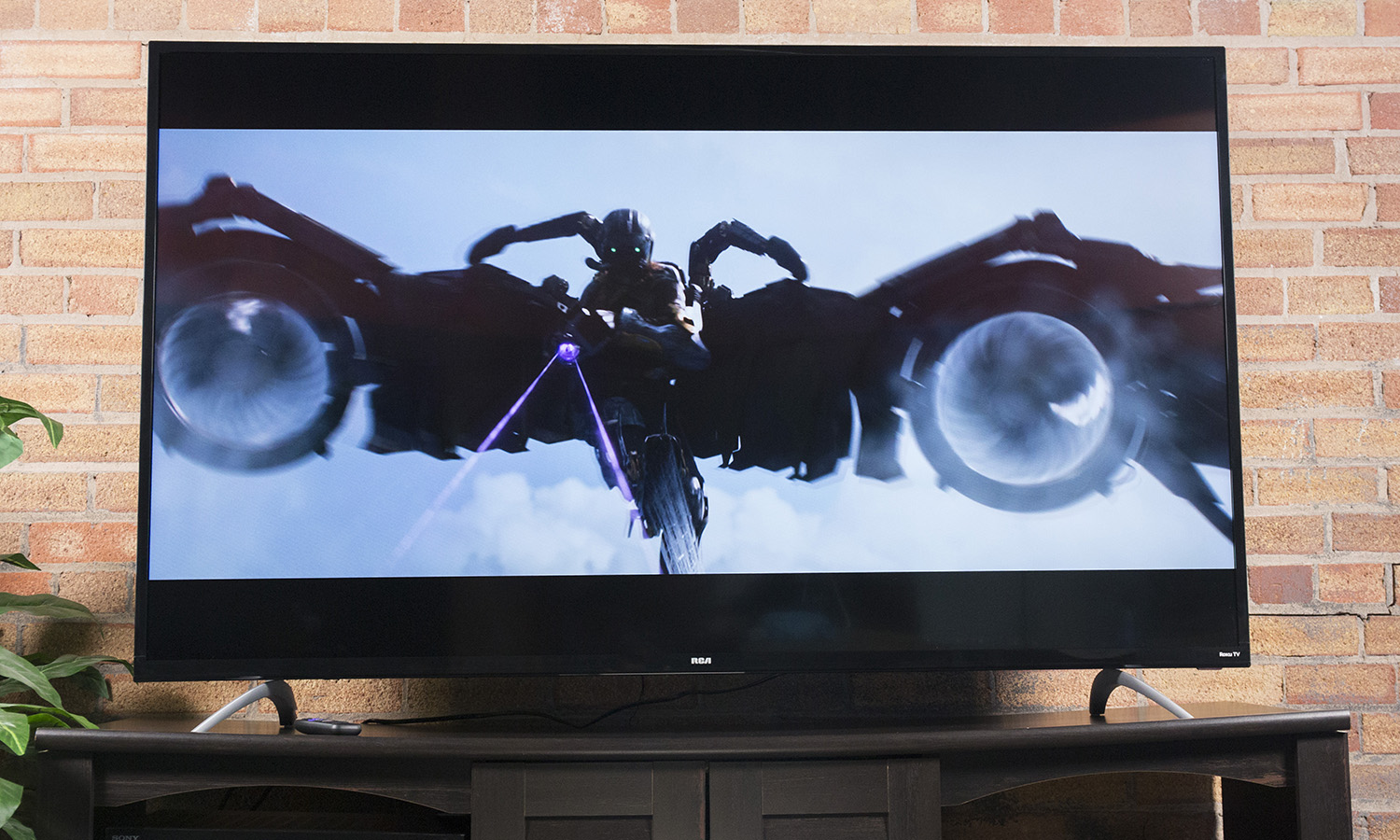Tom's Guide Verdict
The RCA 65-inch Roku 4K TV is a welcome entrant into the more affordable range of 4K TVs, but this model falls flat due to some poor design choices, such as awkward port placement and a backlight that limits HDR support.
Pros
- +
Good port selection
- +
Sharp 4K picture
- +
Good color accuracy
Cons
- -
Awkward port placement
- -
No local dimming
- -
Limited HDR support
- -
Narrow viewing angles
Why you can trust Tom's Guide
The RCA 65-inch Roku TV is a fairly affordable $630 4K TV from a brand that's largely faded from buyers' minds. In a play to get up to speed in the modern market, RCA is offering a smart TV with 4K resolution and basic HDR support. It's a passable budget TV, but the price isn't quite as budget-friendly as what you'll find from rival TV makers.
RCA 65-inch Roku TV (RTRU6527-US) Specs
| Price | $629.99 |
| Screen Size | 65 inches |
| Resolution | 3840 x 2160 |
| HDR | HDR10 |
| Refresh Rate | 60Hz |
| Ports | 3 HDMI, USB 2.0 |
| Audio | 2 channel x 8 watt |
| Smart TV Software | Roku TV |
| Size | 37.75 x 63.5 x 3.3 inches |
| Weight | 55.25 pounds |
Design
The RCA is an inexpensive TV, and the design doesn't do much to hide this. The chassis surrounding the display is made of black plastic, with a thick glossy bezel surrounding the screen, and a matte black rear panel. The included stand is comprised of two boomerang-shaped aluminum feet that attach on either side of the TV.
Measuring 37.75 x 63.5 x 3.3 inches, the set is on the thicker side, even when compared with other affordable models.
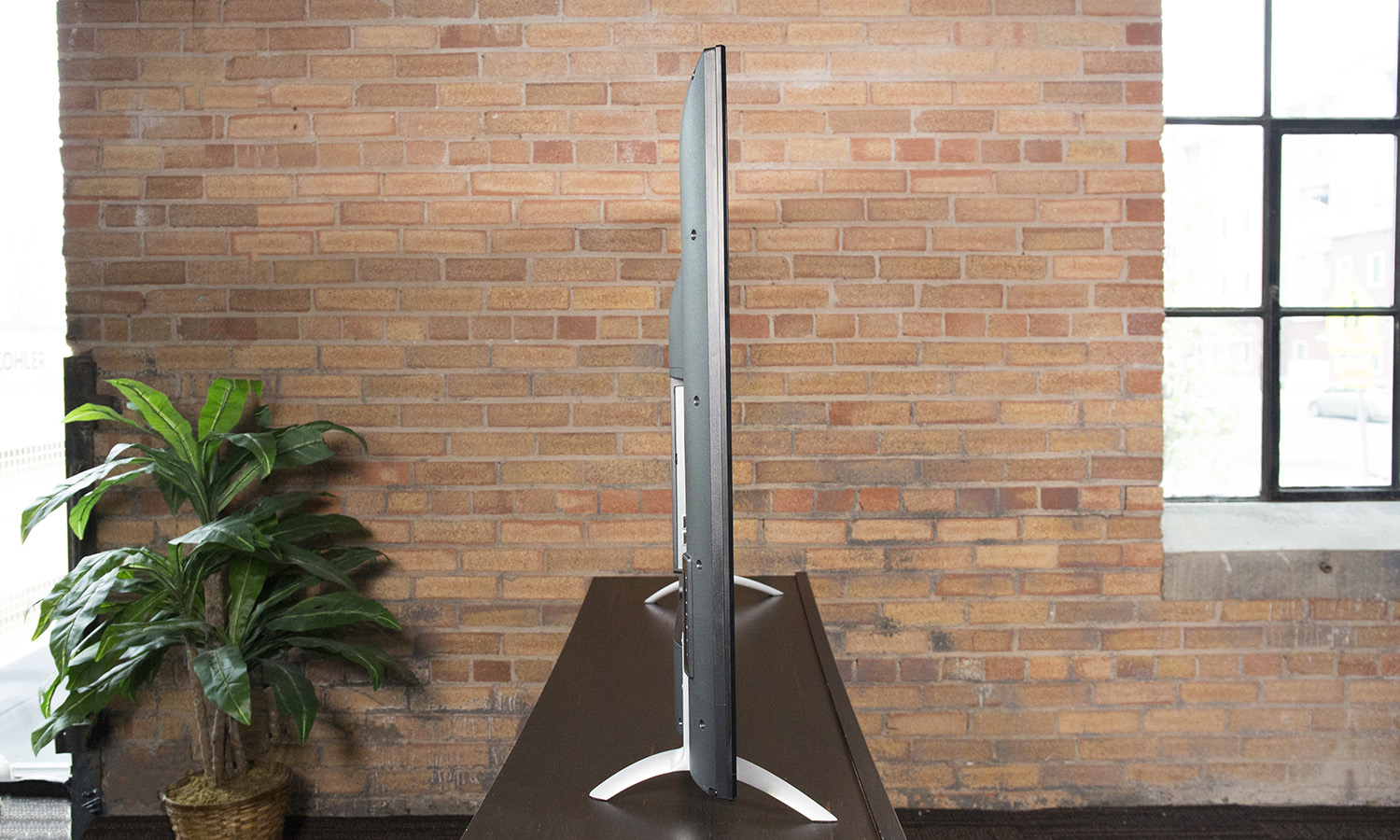
The Vizio E65-e0 is about as thick, at 3.31 inches, but the TCL Roku 55-inch 55S405 (3.0 inches) and the Samsung 55-inch MU6300 (2.5 inches) are both slimmer.

Along the left-hand side of RCA's TV on the rear panel are several built-in control buttons. They let you power the TV on and off, switch between inputs, change the channel and volume, and mute the audio . These buttons are set right along the side of the TV, so they are easy to reach.
Ports
On the rear panel of the 65-inch RCA are all of the TV's inputs. There you'll find three HDMI ports (one with ARC), a trio of composite video connections, two USB 2.0 ports and an RF connector for antenna or cable connections.
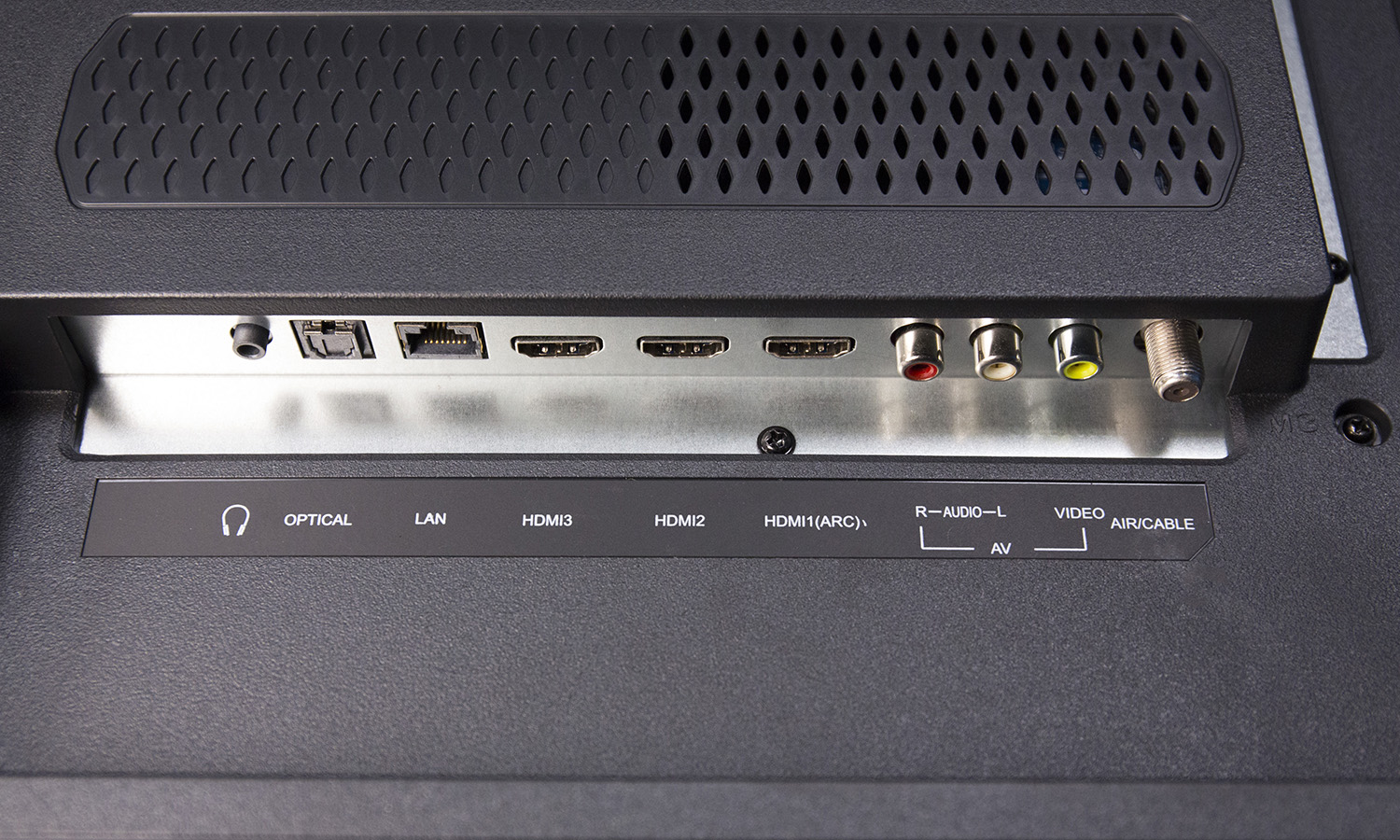
For audio, the set also has a headphone jack for auxiliary output and a digital optical connection for older surround-sound systems. For network connectivity, the TV has both 802.11ac Wi-Fi and a LAN connection for wired networking.
Get instant access to breaking news, the hottest reviews, great deals and helpful tips.

But instead of simply placing these ports on the back in an easy- to-reach position, RCA made the unfortunate choice to set the connector panel a full foot in from the edge of the TV, making it virtually impossible to connect or disconnect a cable without repositioning the TV. Complicating things further, the ports are inset and face down, making the act of plugging in an HDMI cable much more difficult.
Performance
Watching Blade Runner 2049, the 4K resolution on RCA's TV was sharp enough to make out minute details, like the fine grain of the wood-panelled halls of the Wallace Corporation or the intricate pattern on a porcelain teacup. The 60Hz panel also does an admirable job with showing these sorts of tight, densely packed details in motion, with very little of the noisy screen-door effect we often see in less expensive TVs. HDR content, on the other hand, doesn't look as good as it should on the RCA set. For example, the dystopian Los Angeles cityscapes that are peppered with bright lights and neon signs instead looked like a mishmash of color and indistinct, drab shadows.

Some of this lackluster HDR support can be attributed to the display's brightness. RCA claims a maximum brightness of 250 nits, and our testing actually showed better, at 275 nits. But that's still low enough to hamper any sort of HDR effect. By comparison, we saw brighter displays on most of the competing affordable 4K sets, like the Insignia 55-inch Roku TV (351 nits), the Samsung 55-inch MU6300 (332 nits) and the TCL 55S405 (314 nits). Only the Vizio SmartCast E65-E0 (180 nits) fared worse.
Blade Runner 2049's dystopian Los Angeles cityscapes looked like a mishmash of color and indistinct, drab shadows on RCA's set.
On top of this, RCA's set only supports the basic HDR10 format, with no support for more advanced formats, like Dolby Vision or HDR10 Plus. This can be attributed to the RCA's D-led backlight, which has an LED array for direct backlighting, but no discrete dimming. Instead of over-Illuminating dark portions of the screen when trying to properly light bright objects, the backlight simply over-illuminates the entire panel.
MORE: The Best Streaming Video Services for Cord Cutters
The inherent drawback to this approach is a lack of real brightness differentiation, particularly when viewing HDR content. In Spider-Man Homecoming, a fight scene atop a jet had all sorts of light blooming, with the dark sky frequently losing such fine details as the stars.
An even more noticeable issue was the glow that turned black portions of the screen a shining gray. These elevated blacks are especially evident when viewing a letterbox movie, as the black bars on the top and bottom are quite obviously not true black. It also means that some of the subtler qualities brought out by HDR, such as the variation in cloudy skies, appear dulled. It's still a step up from sets with standard dynamic range, but nowhere near what you'll get with sets that have discrete dimming zones. Even compared with sets that have relatively few backlighting zones, such as the Vizio SmartCast E65-E0 and its 12 dimming zones, the RCA struggled to match the more focused backlighting and deeper black levels the Vizio offered.
With a response time of 39 milliseconds, the RCA should be a pretty great inexpensive set for gaming.
The viewing angles are also disappointing. Viewing a solid-purple test screen, I saw color shifting from very little off-axis motion. When standing at a 45-degree angle to the screen, the purples shifted enough that the entire screen looked pink. Vertical viewing angles are equally limited, as differences in color can be seen between sitting and standing.
The weaknesses seen in anecdotal viewing were born out in our lab testing. Even under the best performing mode (standard), the color gamut numbers weren't ideal, with the RCA reproducing 98.5 percent of the sRGB color space. This falls behind the Vizio E65-E0 (99.2 percent) and the Samsung 55-inch MU6300 (99.0 percent) but is similar to the TCL 55S405 (98.4) and significantly better than the Insignia 55-inch Roku TV (96.7 percent). Generally, we like to see numbers closer to 100 percent, since it indicates better color quality overall.
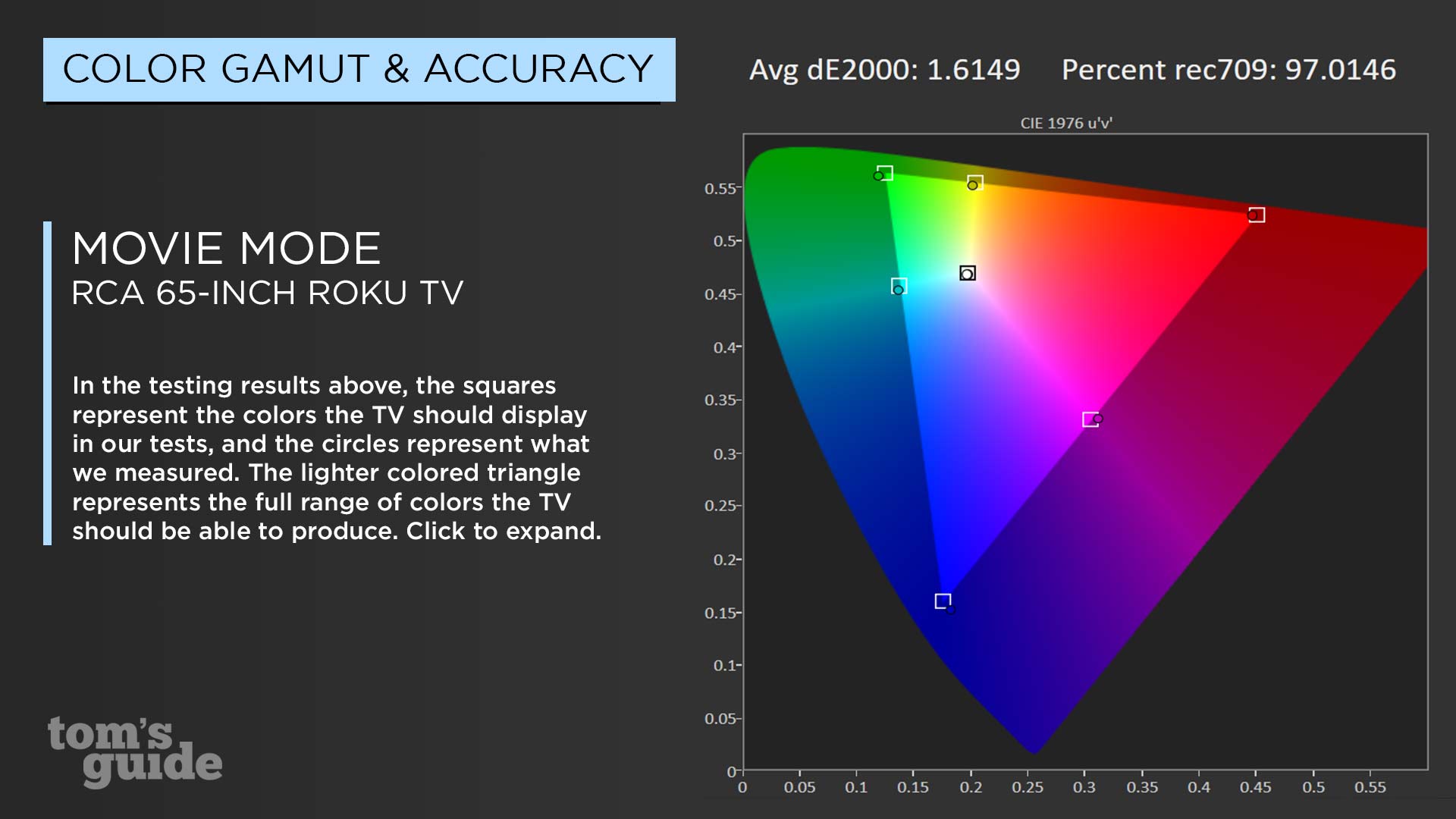
As measured with our X-Rite colorimeter, the TV had a Delta-E score of 1.61 (closer to zero is better) using the best quality setting available, Movie mode. Although that's better than we've seen on some affordable sets, such as the Insignia NS-55DR620NA18 (2.03) and the TCL 55S405 (2.17), it's not as accurate as the Vizio SmartCast E65-E0 (1.37).
With a response time of 39 milliseconds, the RCA should be a pretty great inexpensive set for gaming. Even some of the pricier smart TVs on the market have response times ranging upward of 50 milliseconds, but when split-second timing is the difference between victory and defeat, you'll definitely want something in the single digits.
Audio
The RCA comes outfitted with a pair of 8-watt speakers, which manage to drive a surprising amount of sound. The volume output from the two speakers can get quite loud, with even 50 percent volume pumping out enough sound to not only fill the room but be heard in the next room over. The only problem with this audio is that around 70 percent volume, there is some noticeable distortion that only gets worse as the volume increases; you’ll also notice an audible reverberation of the chassis.
MORE: Best Smart Speakers
Bass levels are better than expected, but they tend to overwhelm the rest of the audio. As I listened to Kevin MacLeod's "Fearless First," the driving bass sounded quite full, but the lighter flute melody frequently was echoey and distant.
Smart Features
Like other manufacturers, including TCL and Insignia, RCA has opted to use Roku's smart TV interface for its connected functions. This may be the best decision made in the design of this set, as Roku's interface is both intuitive to use and full-featured. Setup is quick and simple, requiring you to create a Roku account (or sign into an existing one) and then sync the TV to that account. Even if you have to create a new account, the entire process can be done in 5 minutes.
RCA has opted to use Roku's smart TV interface for its connected functions. This may be the best decision made in the design of this set.
Roku's tiled icon layout is easy to understand, easy to navigate with the directional pad on the Roku remote, and customizable enough to let any user set up the TV with their preferred apps and services. With thousands of apps and streaming channels to choose from, including popular services like SlingTV, Netflix, Hulu, HBO Now and YouTube, cord-cutters won't have much trouble putting together a robust replacement to cable or satellite, or merely supplementing their regular viewing with loads of free content.
Remote
The Roku remote is virtually identical to the Roku-branded remote controls offered by TCL and Insignia. The small remote fits easily into your hand, and isn't overloaded with too many buttons. The purple directional pad in the center of the remote will be familiar to anyone who has used a Roku device, and easy to grasp for newcomers.
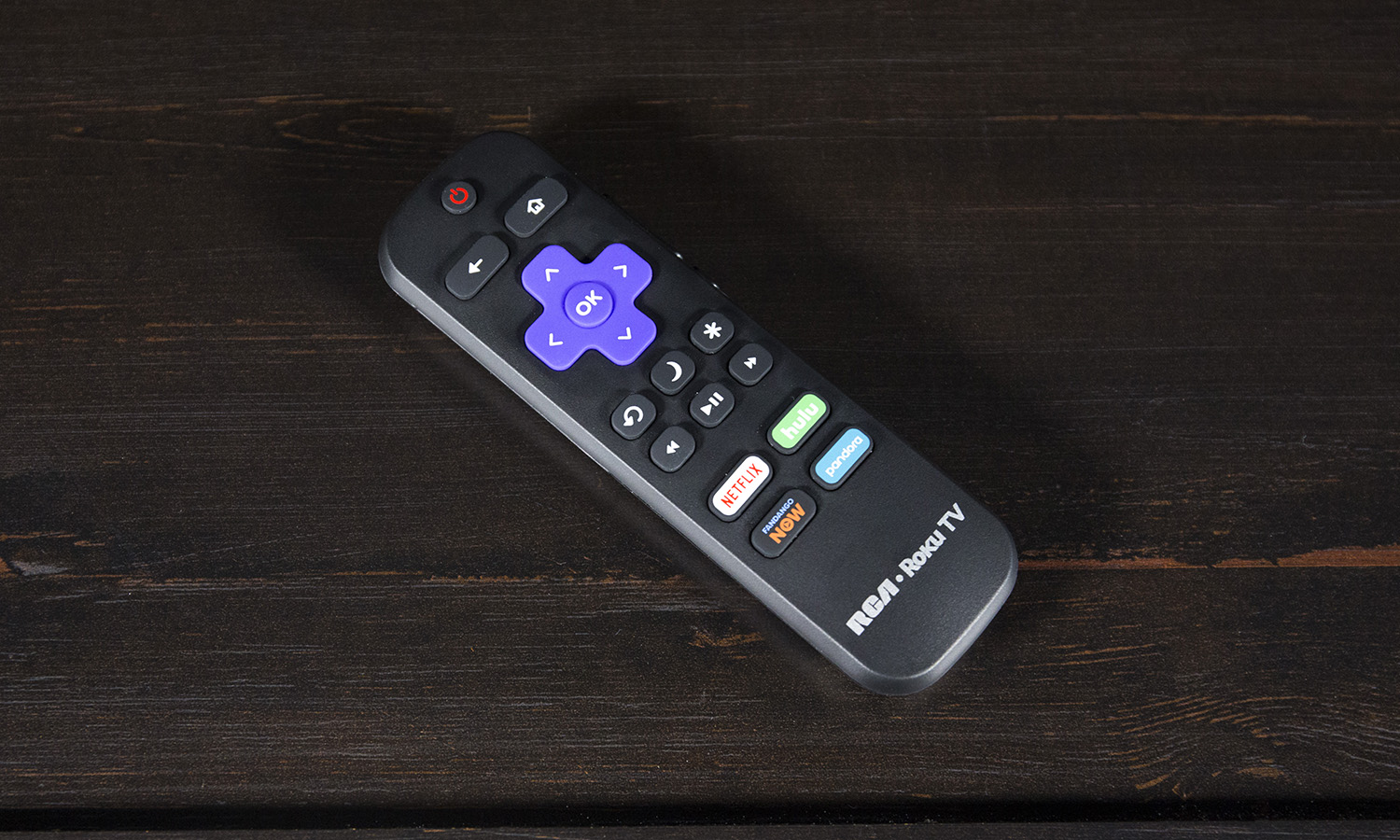
Other navigational buttons, such as home back and media playback controls, are clearly labeled with easy-to-understand icons. The side of the remote features a rocker switch for turning volume up and down and a separate button to mute audio. There are also four dedicated app buttons, offering one-touch access to featured apps, in this case Netflix, Hulu, Fandango Now and Pandora.
MORE: Our Favorite Streaming Media Players and Sticks
One nice touch is that unlike most Roku remotes we have seen, the RCA version has a matte finish instead of the usual glossy black plastic. While this is entirely subjective, I think it feels better when held in my hand, and I appreciate that it doesn't collect fingerprints the way a piano-gloss finish does.
Entirely absent from the remote are Roku's more premium audio and voice features. There is no built-in headphone jack for private listening, nor is there a built-in microphone for voice-search capability. Those looking to use these functions, however, can still access them using the Roku app on their smartphone.
Bottom Line
The RCA 65-inch Roku TV looks pretty great on paper, with 4K resolution, HDR support, a solid Smart TV platform and a pretty decent price. Unfortunately, the reality isn't quite up to expectations: HDR support is limited in format and visible effects, and the Roku platform is standard for inexpensive TVs. Despite these letdowns, the TV has OK sound with clear dialogue and great volume, and the basic performance is more than good enough for people who aren't too picky.
That said, although the price is in the affordable range for a 65-inch TV, it's not the best value out there. We much prefer the Vizio SmartCast E-Series E65-E0 for its superior picture quality, and the TCL Roku 55-inch 55S405 for its similar combination of performance and Roku smarts at a much more affordable price.
Credit: Tom's Guide
Brian Westover is currently Lead Analyst, PCs and Hardware at PCMag. Until recently, however, he was Senior Editor at Tom's Guide, where he led the site's TV coverage for several years, reviewing scores of sets and writing about everything from 8K to HDR to HDMI 2.1. He also put his computing knowledge to good use by reviewing many PCs and Mac devices, and also led our router and home networking coverage. Prior to joining Tom's Guide, he wrote for TopTenReviews and PCMag.
